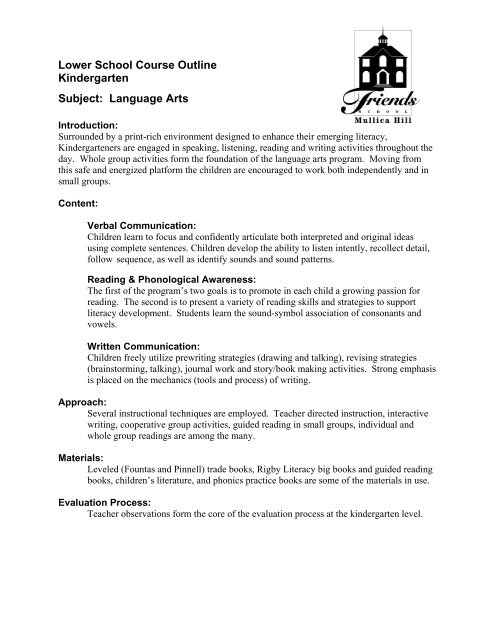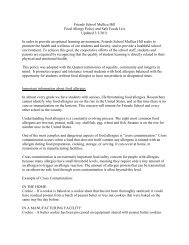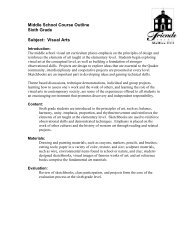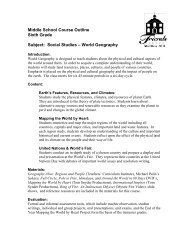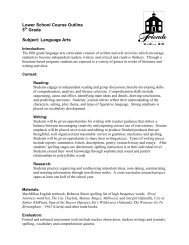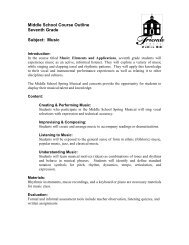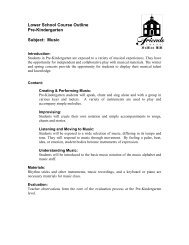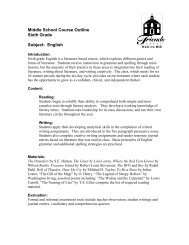Lower School Course Outline Kindergarten Subject: Language Arts
Lower School Course Outline Kindergarten Subject: Language Arts
Lower School Course Outline Kindergarten Subject: Language Arts
You also want an ePaper? Increase the reach of your titles
YUMPU automatically turns print PDFs into web optimized ePapers that Google loves.
<strong>Lower</strong> <strong>School</strong> <strong>Course</strong> <strong>Outline</strong><br />
<strong>Kindergarten</strong><br />
<strong>Subject</strong>: <strong>Language</strong> <strong>Arts</strong><br />
Introduction:<br />
Surrounded by a print-rich environment designed to enhance their emerging literacy,<br />
<strong>Kindergarten</strong>ers are engaged in speaking, listening, reading and writing activities throughout the<br />
day. Whole group activities form the foundation of the language arts program. Moving from<br />
this safe and energized platform the children are encouraged to work both independently and in<br />
small groups.<br />
Content:<br />
Verbal Communication:<br />
Children learn to focus and confidently articulate both interpreted and original ideas<br />
using complete sentences. Children develop the ability to listen intently, recollect detail,<br />
follow sequence, as well as identify sounds and sound patterns.<br />
Reading & Phonological Awareness:<br />
The first of the program’s two goals is to promote in each child a growing passion for<br />
reading. The second is to present a variety of reading skills and strategies to support<br />
literacy development. Students learn the sound-symbol association of consonants and<br />
vowels.<br />
Written Communication:<br />
Children freely utilize prewriting strategies (drawing and talking), revising strategies<br />
(brainstorming, talking), journal work and story/book making activities. Strong emphasis<br />
is placed on the mechanics (tools and process) of writing.<br />
Approach:<br />
Several instructional techniques are employed. Teacher directed instruction, interactive<br />
writing, cooperative group activities, guided reading in small groups, individual and<br />
whole group readings are among the many.<br />
Materials:<br />
Leveled (Fountas and Pinnell) trade books, Rigby Literacy big books and guided reading<br />
books, children’s literature, and phonics practice books are some of the materials in use.<br />
Evaluation Process:<br />
Teacher observations form the core of the evaluation process at the kindergarten level.
<strong>Lower</strong> <strong>School</strong> <strong>Course</strong> <strong>Outline</strong><br />
<strong>Kindergarten</strong><br />
<strong>Subject</strong>: Math<br />
Introduction:<br />
While building on a mastery of basic skills, the <strong>Kindergarten</strong> math program emphasizes<br />
conceptual understanding and problem solving, as it is specifically applicable to everyday<br />
situations. Children explore the full math spectrum using a variety of concrete materials during<br />
partner, small group and whole group activities.<br />
Content:<br />
Numeration:<br />
Children learn to count, read, write, and compare numbers from 1 to 100.<br />
Operations and Computations:<br />
Children identify and use symbols (the same/equal to, addition and subtraction) as they<br />
create and solve a variety of number stories.<br />
Data and Chance:<br />
Children create and interpret various graphs, make predictions and analyze outcomes.<br />
Geometry:<br />
Children experiment with geometric shapes, compare their attributes, construct and<br />
analyze two and three-dimensional shapes.<br />
Measurement:<br />
Using formal and informal tools, the student explore and experiment with measurements<br />
of length, height, weight, volume, time and money.<br />
Patterns and Functions:<br />
Children explore the many facets of pattern making including generating, identifying,<br />
copying and extending patterns. Students examine number relationships through games<br />
and activities.<br />
Approach:<br />
A variety of instructional techniques are utilized. Teacher directed instruction leads to<br />
manipulative and inquiry based experiences. Cooperative group work and active student<br />
participation are also essential components.<br />
Materials:<br />
Trade books, manipulative materials, project construction, charts and graphs, measuring tools<br />
and games comprise the materials list.<br />
Evaluation Process:<br />
Teacher observations form the core of the evaluation process at the <strong>Kindergarten</strong> level.
<strong>Lower</strong> <strong>School</strong> <strong>Course</strong> <strong>Outline</strong><br />
<strong>Kindergarten</strong><br />
<strong>Subject</strong>: Social Studies<br />
Introduction:<br />
Children are immersed in various, rich experiences that build on the child’s understanding of self<br />
and their immediate world. These experiences initiate an appreciation of diverse peoples, their<br />
cultures and their place in our global community.<br />
Content:<br />
Self-awareness:<br />
The children explore the question “Who am I?” in terms of physical, social, and<br />
emotional attributes. Children use drawing, dramatization and project development to<br />
learn about themselves and others. Children are introduced to a conflict resolution<br />
program to actively help them learn peaceful problem solving skills.<br />
Community awareness:<br />
Children answer the question “Where do I fit into the community of classroom, school,<br />
village, state and country?” Service projects inform children’s ideas about their potential<br />
as ambassadors for their communities and help them to positively respond to the needs of<br />
others.<br />
Global awareness:<br />
By exploring the question “How do I find out about the big world I live in?” the children<br />
encounter the idea of likes and differences, tolerance, and respect. Research assignments,<br />
holiday traditions and the telling of history pertinent to specific occasions all promote a<br />
greater understanding of the big wide world.<br />
Service Learning:<br />
Students participate in school-wide service projects to promote an awareness of others’<br />
needs and to encourage a desire to help others. Under the guidance of the teacher, a class<br />
will recognize a need for service and will take leadership for implementing a school-wide<br />
project.<br />
Approach:<br />
Students are immersed in the process of observing change in the world around them. Children’s<br />
literature prompts discussion, investigation and discovery. Art projects act to consolidate<br />
processed information and form response vehicles.<br />
Materials:<br />
Children’s literature, trade books and child-developed research projects (via internet, library, and<br />
videos), topical art and construction projects are the materials used in the social studies program.<br />
Evaluation Process:<br />
Teacher observations form the core of the evaluation process at the <strong>Kindergarten</strong> level.
<strong>Lower</strong> <strong>School</strong> <strong>Course</strong> <strong>Outline</strong><br />
<strong>Kindergarten</strong><br />
<strong>Subject</strong>: Science<br />
Introduction:<br />
The <strong>Kindergarten</strong> science program is designed to build on the children’s natural curiosities<br />
concerning the world around them. The concept of CHANGE links a variety of learning<br />
experiences and investigations that are adaptable to the varied interests and abilities of each<br />
child. Concurrently, these experiences encourage each child to develop reliable observation<br />
techniques that they can utilize in problem-solving situations throughout life.<br />
Content:<br />
Scientific Inquiry:<br />
Beginning with the question “What do you know?”, the children engage in the discovery<br />
process. Observation skills are introduced and practiced. Resources are identified and<br />
examined both individually and in group activity. Information is then shared by and<br />
among the students.<br />
Earth and Life Science:<br />
With the study of the life cycle of the butterfly as a central focus, students explore the<br />
change of seasons, animal habitats and behavior, plant life and ecological responsibility.<br />
The students learn about the Earth’s rotation and its orbit around the sun. The students<br />
learn about the moon’s orbit around the Earth.<br />
Physical Science:<br />
The students learn about their five senses and become adept at using their sense of sight,<br />
hearing, touch, taste and smell as they discover new information.<br />
The students investigate the properties of magnets.<br />
Health Science:<br />
The children participate in a trimester of yoga classes. Healthy foods are identified and<br />
encouraged for meals.<br />
Approach:<br />
Science instructional techniques are varied, yet remain inquiry-based. Topical literature, careful<br />
observations and documentation of observations are the constructs of scientific discovery in<br />
<strong>Kindergarten</strong>.<br />
Materials:<br />
Trade books, children’s literature, project construction, observation journals and the natural<br />
world provide hands-on, concrete materials to aid the learning process.<br />
Evaluation Process:<br />
Teacher observations form the core of the evaluation process at the <strong>Kindergarten</strong> level.


